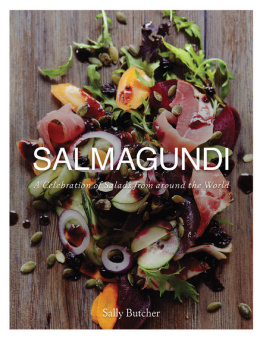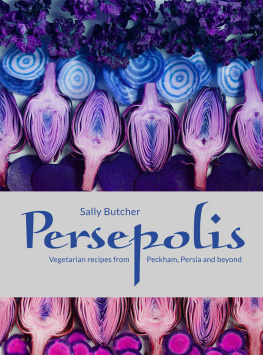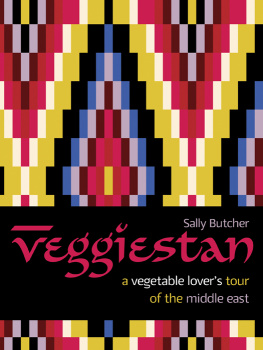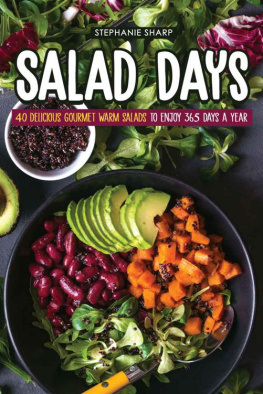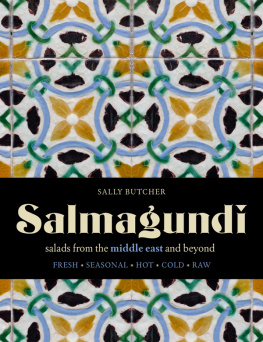SALMAGUNDI

SALMAGUNDI
A Celebration of Salads from around the World
Sally Butcher
Photography by Yuki Sugiura


CONTENTS
INTRODUCTION
A question. If someone tells you that its salad for dinner, isnt there a teensy petulant you inside that stomps their foot a little at the prospect of being fed rabbit food as a repast? Be honest now. You are not alone: back in the (seventeenth century) day one Robert Burton wrote: Some are of the opinion that all raw herbs and sallets breed melancholy blood. We have all had luscious salads full of melty cheese, naughty croutons, and sizzled meat or fish, but still the initial mention of salad immediately conjures visions of floppy lettuce, diet clubs, detoxing, and virtuosity. Or very sad garnishes composed of wilted round lettuce leaves and slightly sweaty tomatoes.
What are your first salad day memories? Apart from my grandfathers wonderful (basic) , my childhood resonates with the clickety-clack of mid-air salads being cobbled together on melamine plates. My dreamer of a father believed that life was for living, and was quite happy to make sacrifices (sell my grandmother, send the cat out on a paper route, you know, that sort of thing) so that we could have adventures (this gave my mother a lot of headaches and me the best childhood imaginable). So first there was a trailer, then a boat. And anyone who has ever camped or boated will know that one of the best sounds of the day is that special noise that plastic camping crockery makes as it is readied for lunch/the evening meal. My mother would produce an astonishing variety of meals out of a tiny galley, but the lettuce, tomato, cucumber, scallion salads were always snipped and shredded mid-air with a weensy knife and tumbled onto a plate with salad cream. (My mother-in-law still prepares salads this way, and looks at me with amusement as I sharpen my knife, get out a chopping board, and start assembling ingredients.) The point is, for many of us, being allowed to help make a salad rates among one of our first experiences in the kitchen.
Thing is, you can make anything into a salad. There are no rules. If you want steak and fries in your salad, or fruit and nuts, or 10 types of cheese, well, theres nothing stopping you. Salads can be hot, cold, or somewhere in between. (They may comprise cooked ingredients, but unless you are cooking everything up together, the combo is a salad, not a stew.)
Furthermore, you dont have to go out and buy special materials for a salad: you can always find things in your fridge, your pantry, or your veggie drawer that can be pressed into service. Go with the seasons, the weather, or circumstance.
Salad, you see, is a state of mind. Its all about finding ingredients that will play nicely together in one bowl. Its about having a feel for things that work, and the willingness to let your imagination travel.
Salmagundi, for those of you who have not yet encountered it on a trivia night somewhere, is a seventeenth-century English expression denoting a salad dish comprising, well, everything. The term is derived from the French word salmigondis, but the first recorded mention of it in English comes in an eighteenth-century tome by well-known plagiarist Hannah Glasse. I include here the recipe in full for your culinary delight, wonderfully random CAPITAL LETTERS and all:
To Make Salamongundy
Take two or three Roman or Cabbage Lettice, and when you have washed them clean, swing them pretty dry in a Cloth; then beginning at the open End, cut them cross-ways, as fine as a good big Thread, and lay the Lettices so cut, about an Inch thick all over the Bottom of the Dish. When you have thus garnished your Dish, take a Couple of cold roasted Pullets, or Chickens, and cut the Flesh off the Breasts and Wings into Slices, about three Inches long, a Quarter of an Inch broad, and as thin as a Shilling; lay them upon the Lettice round the End to the Middle of the Dish and the other towards the Brim; then having boned and cut six Anchovies each into eight Pieces, lay them all between each Slice of the Fowls, then cut the lean Meat of the Legs into Dice, and cut a Lemon into small Dice; then mince the Yolks of four Eggs, three or four Anchovies, and a little Parsley, and make a round Heap of these in your Dish, piling it up in the Form of a Sugar-loaf, and garnish it with Onions, as big as the Yolk of Eggs, boiled in a good deal of Water very tender and white. Put the largest of the Onions in the Middle on the Top of the Salamongundy, and lay the rest all round the Brim of the Dish, as thick as you can lay them; then beat some Sallat-Oil up with Vinegar, Salt and Pepper and pour over it all. Garnish with Grapes just scalded, or French beans blanched, or Station [nasturtium] Flowers, and serve it up for a first Course.
She mentions two other salmagundis, both comprising multiple minced ingredients layered with salad greens and garnished with lemon, barberries (interestingly enough), and astertion (probably nasturtium) flowers. In the third recipe she somehow captures the very essence of this book when she writes: This is a fine middle-dish for supper; but you may always make salamongundy of such things as you have, according to your fancy.
Salmagundi is not in any obvious way related to the childrens rhyme, Solomon Grundy, but it may have given rise to the Caribbean dish Solomon Gundy: a paste comprising all sorts of stuff. The nearest modern equivalent is perhaps , a Guatemalan salad containing in excess of 20 ingredients.
A Potted History of Salletting
Yup, salletting is a thing, a real verb, albeit a somewhat archaic one, meaning to make salads. But who are the salad heroes of yesteryear?
The practice started with the Romans. Now I am no fan of the Romans, as I generally regard them as copycats rather than innovators, the Borg of antiquityalthough for the most part they managed to assimilate without destroying stuff. But when it comes to gastronomy, I am in awe of their achievements. Their understanding of subtle flavors and balance, and their sheer delight in food was something new in the ancient world. They, via the medium that is mostly known as Apicius and his book De Re Coqinaria, recorded the first instances of herbs and other ingredients being prepared as salata (from the Latin word sal, or salt). Simple leaf salads were eaten as part of the gustatio (the Romans first course of appetizers). There are various (and frankly fairly bizarre) recipes for composed, layered, as well.
There is not much salad action thereafter until the Middle Ages. Impressive works that reference salads were brought out in Italy and France, but the first one in English was a fourteenth-century book called Forme of Cury (as in the French verb cuire, to cook, as opposed to an early work on curries). The unknown author suggests that we:
Take persel, sawge, garlec, chibolles, oynouns, leek, borage, myntes, porrectes, fenel and ton tressis, rew, rosemarye, purslarye, laue and waische hem clene, pike hem, pluk hem small wi yn honde and myng hem wel with rawe oile. lay on vynegur and salt, and serue it forth.
Which after a lot of humming and hah-ing I reckon probably transcribes as:

